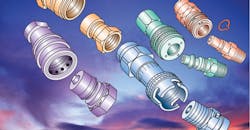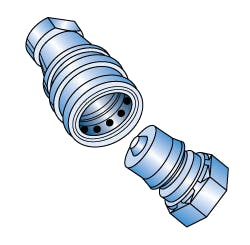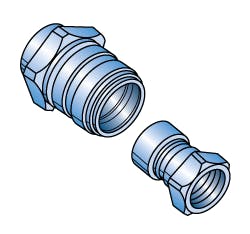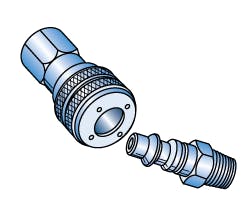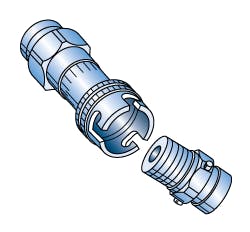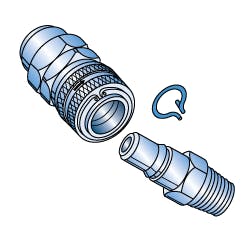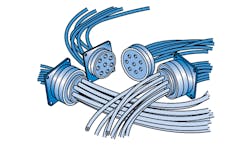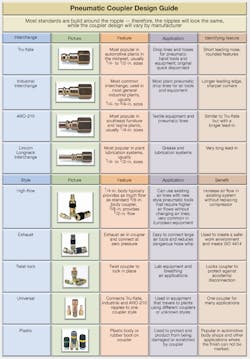Download this article as a .PDF
If a hose or tubing in a pneumatic system will be connected and disconnected more frequently than once a week, chances are a quick-acting coupling will pay for itself rapidly by improving productivity. Although simple in concept, many quick-acting couplings are precisely engineered for specific applications. Their widespread use over many years has produced a wide variety of standard designs.
Regardless of the manufacturer, all quick-acting couplings have some elements in common. All have two parts: a plug and a socket. The plug is the male half and the socket is the female half. When connected properly, these parts seal and lock the joint effectively to contain internal pressures and resist any tensile forces that tend to pull the joint apart. The two parts are easily disconnected without tools by disengaging a locking mechanism and separating the parts.
One common application is in assembly workstations, where a worker may have to rapidly switch from impact wrench to drill to riveter. With one quick-acting coupling half on every tool and the mating half on the air line, tool changing is accomplished in seconds. Without the couplings, separate air lines would be needed for each tool; the mass of tools and lines would clutter the workstation and could slow down production.
Basic Components
A plug may be of one- or two-piece construction. The one-piece version is machined to accept the mating locking mechanism of the female or coupler half. The two-piece is similar, but two machined parts are used to provide flexibility for a variety of end terminations. It may also be used as the retainer for a valve assembly.
The socket is constructed to provide a leak-tight interface with the plug. This requires a sealing surface between the plug and socket. A socket may also be a one- or two-piece construction. The one-piece is a single part machined to accept the configuration of the mating plug and to provide a leak tight seal. The two-piece is similar but has a second part to retain an internal valve assembly, or to provide flexibility for a variety of end configurations
Pneumatic systems generally use a single-shutoff valve coupling. In this design, the valved coupling half prevents air loss from the system while the joint is disconnected, and the unvalved coupling half allows downstream air to bleed off. (In hydraulic applications, both coupling halves often are valved, to minimize fluid leakage and limit the amount of air, dirt, and water that can enter the system.)
Coupling Designs
Ball-lock is a common design and has a wide range of applications. A group of balls is positioned in holes located around the ID of the socket body. These holes normally are tapered or stepped to reduce their diameter at the socket body inner diameter (ID), so the balls do not fall into the cavity vacated by the plug when the coupling is disconnected.
A spring-loaded sleeve around the socket body’s outer diameter (OD) forces the balls toward the socket body ID. To connect the plug, the sleeve is pushed back, which opens clearance so the balls are free to move outward. Once the plug is in place, releasing the sleeve forces the balls inward against a locking groove on the OD of the plug. To disconnect, pushing the sleeve back provides the balls with clearance to move outward and allow the plug to be removed.
Roller-lock couplings use locking rollers or pins spaced end-to-end in grooves or slots around the socket’s ID. As the plug is inserted, a ramp on the plug OD pushes the rollers outward. Once the plug is inserted the prescribed distance, the rollers slip into a retention groove on the plug’s OD. Retracting the locking sleeve, which allows the ramp on the plug OD to move the rollers outward, releases the plug.
Pin-lock couplings allow push-to-connect joining using only one hand because the outer sleeve does not need to be retracted to make a connection. In this design, pins are mounted around the socket body ID in a truncated-cone-shaped formation. Pushing the plug into the socket moves the pins back and outward, owing to a ramp on the plug. Shear across pins locks the plug into the socket. Retracting the spring-loaded sleeve, which forces the pins back out of the locking groove, releases the plug from the socket.
Bayonet couplings rely on the familiar twist locking arrangement and are widely used in a variety of applications, especially in plastic couplings for lighter-duty pneumatic equipment. To join the coupling halves, lugs on the OD of the plug engage slots in the socket sleeve as the plug is pushed into the socket. A quick turn locks the lugs into position. Turning the plug in the opposite direction allows the halves to be pulled apart.
Ring-lock couplings use a split ring seated in a groove and slot in the socket. Pushing the plug into position causes a ramp on the plug to spread the ring apart at the split until the ring snaps closed behind a retention shoulder on the plug. Rotating an external sleeve expands the ring, thus releasing it from the retention shoulder so the halves can be pulled apart. This design provides maximum flow in a small envelope for normal shop air applications. A variation of this design uses jaws instead of a split ring to lock the parts together.
Coupling Selection
Before selecting a coupling, questions must be answered regarding its expected performance. How often will the coupling be connected and disconnected? What type and diameter of hose or tubing will be used? Will the coupling or hose be subjected to abuse such as impact from falling objects, severe vibration, or contamination from the work environment?
A wide variety of O-ring and seal materials—elastomers, PTFE, etc.—is available. Also important is the material chosen for the plug and socket. Steel, stainless steel, brass, and aluminum are common. Lighter and inexpensive couplings made from plastics are often used in pneumatic applications. Most industrial pneumatic couplers are made of brass or steel.
Pressure rating relates to values that provide optimum service life and maximum pressure that can be tolerated without failure. Manufacturer literature should provide data for both of these ratings of pressure. Information should also help in determining safety factors if service rating may be exceeded.
Literature also should include data for determining pressure drop through the coupling at expected flows and pressures. Many of these calculations are based on flow of water at 60° F. Calculations for air are more complex, because a gas’ density varies widely with its pressure and temperature. A general rule to estimate maximum air flow at 100 psig inlet and 5-psi pressure drop is to multiply flow coefficient of the coupling by 25. Often, literature contains more detailed data on maximum air flow at prescribed inlet pressures and pressure drop. Therefore, precise values for pressure drop for specific couplings should be obtained from the manufacturer.
Also be aware that couplings may be subjected to pressures well above the maximum operating pressure. Sudden shifting of valves or abrupt application of heavy loads can cause system pressure to quickly rise and fall within milliseconds. These pressure spikes often go undetected in a system, but still can damage seals and locking elements of the coupling. Ultimately, then, the coupling would develop leaks, become difficult to disconnect or reconnect, or any combination of these. To prevent these problems from occurring, select a coupling with a pressure rating substantially higher than the anticipated maximum operating pressure.
Depending on the application, the coupling may be subjected to vibration or relative rotation between the mating halves while pressurized. In most cases, these conditions will shorten the expected life of the coupling by causing leakage or difficulties in connecting or disconnecting. Therefore, check with the manufacturer to determine if the coupling will tolerate these conditions.
Multi-tube Connectors
As pneumatic systems become more complex and the trend toward modular automation increases, the need to connect and disconnect the growing number of pressure and control lines grows almost exponentially.
Multi-tube connectors are the fluid equivalent to electrical Cannon-style connectors. They quickly and easily connect or disconnect several tubing lines, all the while maintaining a correct line orientation and discrete flow paths during reconnection.
Radial seal multi-connectors use a pin-shaped passage which is inserted into a cavity containing a retained O-ring.
Axial seal style multi-connectors merely mate, instead of sliding into one another. This allows for reduced insertion force, decreased wear, and a smaller overall profile.
This information was excerpted from the Fluid Power Handbook & Directory.
